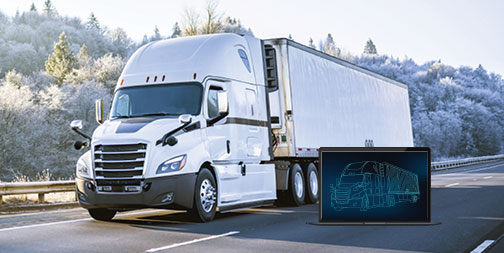What is the Definition of Digital Twin?
A digital twin is a virtual model of a process, product or service. This pairing of the virtual and physical worlds allows analysis of data and monitoring of systems to head off problems before they even occur, prevent downtime, develop new opportunities and even plan for the future by using simulations.

Digital Fleet Twin
Digital twin, the creation of a virtual, but dynamic, representation of fleet operations is a powerful approach to better understand how it works today or could work in the future. With a digital twin, an organization can monitor performance, predict the impact of changes, identify areas for improved productivity or customer service and evaluate new operating models.
Descartes Route Planner addresses the 5 key components that are needed to create a digital twin of your fleet.
Real-world modelling
The real-world of fleet operations is inexact and messy and there are a lot of complex trade-offs between service and cost. The ability to deal with hard and soft constraints for vehicles, products, customers, etc. is critical to creating an accurate operational model of the fleet.
Descartes Route Planner uses location-based services (i.e., digital map technology) where roads are modelled more accurately and there is a wealth of historical, predictive and real-time traffic information. Machine learning adjusts drive, location and stop times to improve model accuracy. In addition, business rules, operational constraints and physical limitations can also be modelled.
Continuous optimization
Digital twins operate in real-time, making or taking decisions that improve operational performance. The notion of planning and dispatching blurs as the optimization engine needs to take in real-time updates to make predictive recommendations on what best to do because of changes to orders, vehicle and driver status, road congestion, etc.
New orders can be evaluated for best delivery options and time-definite delivery including placing those orders or the live dispatch schedule. Descartes Route Planner uses continuous optimization, machine learning, or other forms of artificial intelligence in powerful ways to provide real-time insight such as dynamically calculated ETAs and facilitate autonomous decision-making.
Integrated real-time data
The degree of integration of real-time data sources — mobile, telematics, traffic, etc. — with the continuous optimization technology is critical to the ability of the digital twin to make accurate and timely predictions and decisions. The breadth and depth of data and the sophistication of the interaction goes well beyond capturing regular GPS updates.
In addition, the integration needs to be bidirectional and event-driven to take in order and delivery status changes as they occur and coordinate drivers’ actions on the road.
Scenario management
The ability to test and validate the impact of proposed operational changes or new business models is one of the most powerful capabilities of the digital twin. Most fleet operators want to be more agile but are slowed by the validation process.
With a digital twin, the ability to clone, tweak and run enhanced models against operational data allows organizations to more quickly and accurately assess the cost, service, and other operation impacts of proposed changes. Descartes uses an AI-based technology that provides configuration options that take into account scenario-based business objectives and operational data.
Analytics and forecasting
Not every improvement opportunity happens in real-time. Part of the power of the digital twin is to collect large amounts of data over time to analyze trends.
For example, we had a customer who was collecting four billion data points annually and used that information to simplify and rewrite its stop time model to improve time forecasting and route productivity. Analytics technology is another area where the improvement in sophistication, ease-of-use and cost has also improved dramatically in the last several years to make it more widely adopted and part of the digital twin strategy.
The Benefits of a Digital Fleet Twin (DFT)
- Proactive alerting of operational issues
- Model fleet operations to predict performance
- Assess impact of operational, asset or policy changes
Connect with our team to take the next step towards transforming your business.
Fleet Resource Center
Discover Tutorials, Success Stories, Thought Leadership, and More to
Deepen Your Routing, Mobile, and Telematics Expertise.
Recommended For You



